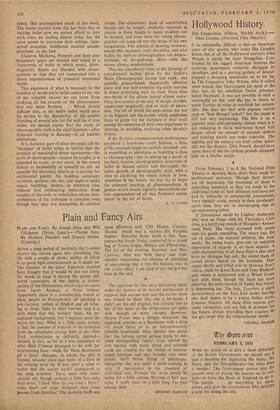Hollywood History
THE CONQUEROR. (Odeon, Marble Arch.)— FREE CINEMA. (National Film Theatre.) 1-r is, admittedly, difficult to find an American actor of star quality who looks like Genghis Khan, but of all the Hollywood warriors John Wayne is surely the least Mongolian. Con- fronted by his rugged American features the make-up department evidently shrugged its shoulders, and as a parting gesture of despair slapped a drooping moustache on to his lip. In The Conqueror John Wayne, who is called what sounds like Thermogene for most of the film, has, as his rebellious Tartar prisoner. Susan Hayward. It was not possible to stick a moustache on her, and she has to resort to sauce Tartare in order to establish her nation- ality. She does her best with piquant retorts such as 'You Mongol jackal!' but the result is still not very convincing. The film is on a gigantic scale and extremely violent when it is not indulging in those wearisome Seven Veil ,dances which no amount of petunia\ chiffon and rotating navels can make tolerable, The fighting and the scenery are both rather splen- did, but the director, Dick Powell, should have spent more of the two million pounds allocated him on a livelier script.
From February 5 to 8 the National Film Theatre is showing three short films made by professional amateurs. Though their themes arc all depressing, the treatment of them Is refreshing inasmuch as they are made to the individual tastes of their directors and have not had to subscribe to commercial conventions. Very cheaply made, mostly in their producers' spare time, they are an encouraging sign of up-and-coming talent.
0 Dreamland, made by Lindsay Anderson, who won an Oscar with his Thursday's Chu• dren, is a terrifying record of Margate's Amuse' ment Park. The faces crowned with paper caps are gaunt, unsmiling. The weary legs, the sea. of paper, the stunned children, the wax- works, the swing boats, give one an indelible impression of tragedy at its most squalid. A joint characteristic of all these films is that they have no dialogue but only the sound track of actual noises heard on the locations. Thus pagan throbs and tribal cries in Momma Don't Allow, made by Karel Reiss and Tony Richard'
son, which is concerned with a Wood Green jazz club, Here, though the faces are more cheerful, the undercurrent of Teddy boy frenzy is depressing too. The best, Together, a silent documentary on the East End docks starring two deaf mutes, is by a young Italian artist.
Lorenza Mazetti. All these films express per- sonal viewpoints and are full of promise for the future, always providing their creators do not get swept into the CinemaScope world.
VIRGINIA GRAHAM


































 Previous page
Previous page